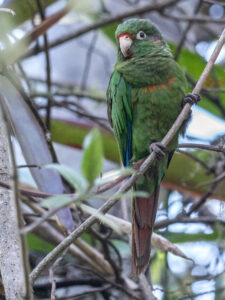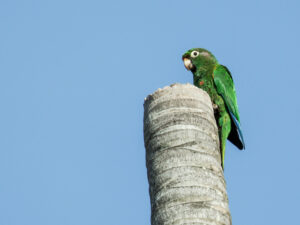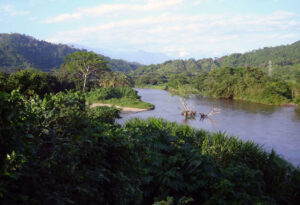
The Sierra Nevada de Santa Marta (SNSM) in northern Colombia has a one-of-a-kind ecosystem, unique because it is the world’s most elevated coastal mountain formation. Independent of the Andes mountain range central to Colombia, SNSM includes mountain peaks with an elevation of over 18,700 feet and is just 26 miles from the Caribbean coast. In 1979, UNESCO declared it a special Biosphere Reserve.
The Santa Marta Parakeet (Pyrrhura viridicata), or the Santa Marta Conure in more common terms, can be found only on an isolated mountain range in SNSM, and it is one of the most threatened parrots in the Neotropics. It is now considered Endangered by the IUCN with an estimated population of 1,800-3,200. It is also listed on Appendix II of CITES. The pet trade is not the primary concern for this species—the main threat is loss of habitat due to plantations for non-native trees, such as pine and Eucalyptus, as well as agriculture, logging, and pasture for livestock.
Combining Conservation Forces

Three organizations decided to work together to help the parrots of northern Colombia and specifically the Santa Marta Conure. These organizations are: The World Parrot Trust, ProCat Colombia (Proyecto de Conservación de Aguas y Tierras), and SELVA: Research for Conservation in the Neotropics. The goal of this organizational trifecta is to recruit interest amongst the rural indigenous people to help monitor and protect this endangered species.
This conure nests in dead wax palms, and usually two times a year because there is growing competition for nests with larger parrot species. They inhabit primarily wetland forests on the northern side of the mountains and, with the continued expansions of farms, they are mostly found at elevations 6,000-10,000 feet.
An Assist from Local Communities

Because these birds are living at higher levels, it is increasingly difficult for scientists to conduct regular research. But the Santa Marta Conure can be easily spotted in the field, so it’s possible to engage more help from the local population, the key to any conservation effort. As the community takes more responsibility for monitoring and protecting the Santa Marta Conure, scientists will also benefit from increased information from the less habitable areas. So together, these three NGOs are seeking to locate and train local individuals who can identify and track the population, and assist in collecting data about their nesting, mating, and feeding habits. Another aim of the project is to empower women and show them that protecting the species can also help to protect their land and families.
This month’s Lafeber grant goes to support these three NGOs and their citizen scientist initiative, which is to recruit more participation from those living in the less habitable areas, with a particular emphasis on empowering women in the effort to save the beautiful Santa Marta Conure.

9 Comments